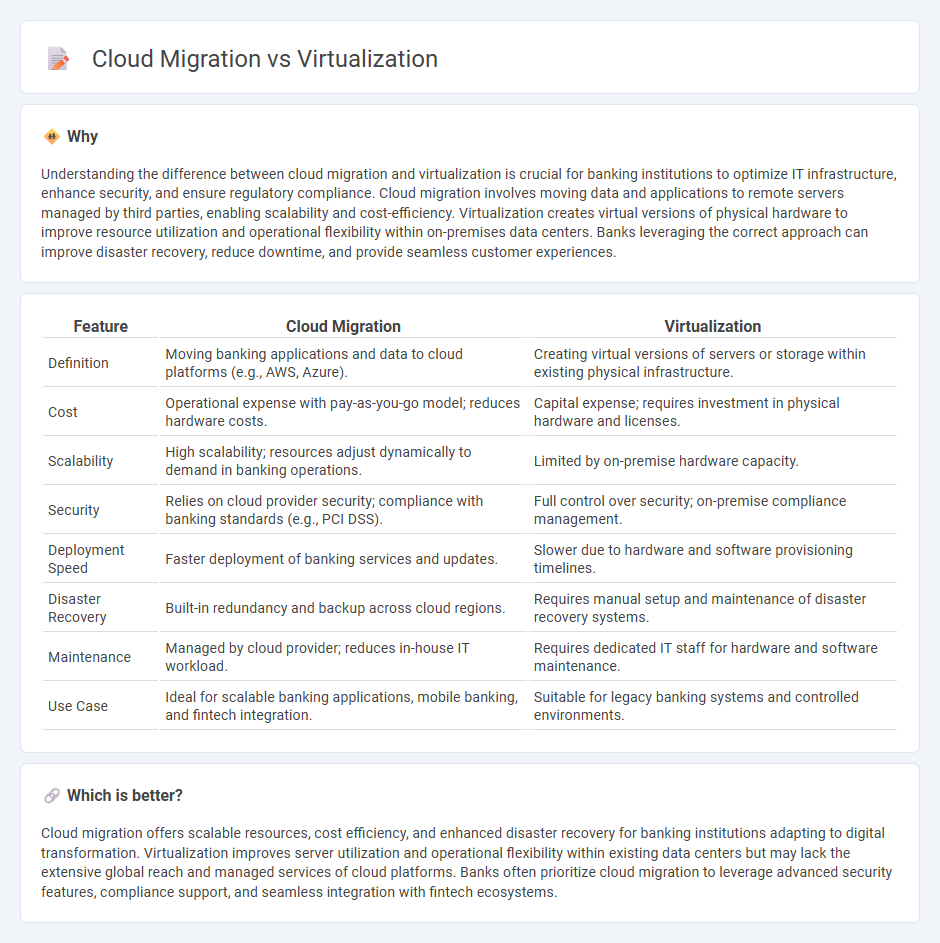
Cloud migration transforms banking infrastructure by moving data and applications to remote servers, enhancing scalability and reducing operational costs. Virtualization allows banks to create multiple simulated environments from a single physical system, improving resource utilization and flexibility. Explore how these technologies revolutionize financial services efficiency and security.
Why it is important
Understanding the difference between cloud migration and virtualization is crucial for banking institutions to optimize IT infrastructure, enhance security, and ensure regulatory compliance. Cloud migration involves moving data and applications to remote servers managed by third parties, enabling scalability and cost-efficiency. Virtualization creates virtual versions of physical hardware to improve resource utilization and operational flexibility within on-premises data centers. Banks leveraging the correct approach can improve disaster recovery, reduce downtime, and provide seamless customer experiences.
Comparison Table
| Feature | Cloud Migration | Virtualization |
|---|---|---|
| Definition | Moving banking applications and data to cloud platforms (e.g., AWS, Azure). | Creating virtual versions of servers or storage within existing physical infrastructure. |
| Cost | Operational expense with pay-as-you-go model; reduces hardware costs. | Capital expense; requires investment in physical hardware and licenses. |
| Scalability | High scalability; resources adjust dynamically to demand in banking operations. | Limited by on-premise hardware capacity. |
| Security | Relies on cloud provider security; compliance with banking standards (e.g., PCI DSS). | Full control over security; on-premise compliance management. |
| Deployment Speed | Faster deployment of banking services and updates. | Slower due to hardware and software provisioning timelines. |
| Disaster Recovery | Built-in redundancy and backup across cloud regions. | Requires manual setup and maintenance of disaster recovery systems. |
| Maintenance | Managed by cloud provider; reduces in-house IT workload. | Requires dedicated IT staff for hardware and software maintenance. |
| Use Case | Ideal for scalable banking applications, mobile banking, and fintech integration. | Suitable for legacy banking systems and controlled environments. |
Which is better?
Cloud migration offers scalable resources, cost efficiency, and enhanced disaster recovery for banking institutions adapting to digital transformation. Virtualization improves server utilization and operational flexibility within existing data centers but may lack the extensive global reach and managed services of cloud platforms. Banks often prioritize cloud migration to leverage advanced security features, compliance support, and seamless integration with fintech ecosystems.
Connection
Cloud migration in banking leverages virtualization to create scalable, flexible IT infrastructure that supports seamless data management and application deployment. Virtualization enables banks to run multiple virtual machines on a single physical server, reducing hardware costs and improving resource utilization during the cloud migration process. This synergy enhances operational efficiency, security, and disaster recovery capabilities essential for modern financial institutions.
Key Terms
Infrastructure as a Service (IaaS)
Virtualization enables multiple virtual machines to run on a single physical server, optimizing resource utilization and reducing hardware costs, while cloud migration to Infrastructure as a Service (IaaS) involves moving these virtualized resources to a cloud provider, offering scalable, on-demand computing power and managed infrastructure. IaaS platforms such as AWS, Microsoft Azure, and Google Cloud provide elasticity, automated management, and global data center access, streamlining deployment and disaster recovery processes. Explore in-depth benefits and strategies for maximizing efficiency with virtualization and cloud migration in IaaS environments.
On-Premises Virtualization
On-premises virtualization involves creating virtual versions of physical hardware to maximize resource utilization within a local data center, improving scalability and reducing hardware costs. Cloud migration shifts these virtualized systems to cloud environments, enabling flexible access, disaster recovery, and pay-as-you-go pricing models. Explore the key differences and benefits of on-premises virtualization versus cloud migration to optimize your IT infrastructure strategy.
Data Security Compliance
Virtualization enables the creation of multiple simulated environments on a single physical hardware, enhancing resource utilization while maintaining control over data security compliance through isolated virtual machines. Cloud migration involves transferring data, applications, and workloads to cloud platforms like AWS, Azure, or Google Cloud, which require adherence to stringent security standards such as GDPR, HIPAA, and SOC 2. Explore how these technologies impact data protection strategies and regulatory compliance for your enterprise.
Source and External Links
What is virtualization? - Red Hat - Virtualization is a technology that creates virtual environments from a single physical machine, allowing multiple operating systems to run alongside each other sharing resources efficiently, offering benefits like server consolidation, cost savings, isolated environments, faster application migration, efficient testing, and disaster recovery options.
What is Virtualization? - Cloud Computing Virtualization Explained - Virtualization uses a hypervisor, either type 1 (bare-metal) or type 2 (hosted), to create multiple virtual machines (VMs) on one physical host, each VM behaving like an independent computer with its own OS and access to physical resources coordinated by the hypervisor.
What Is Virtualization? | IBM - Virtualization enables the creation of multiple virtual machines from a single physical system by abstracting hardware components, allowing efficient resource use and scalability, and is foundational for cloud computing and enterprise IT architectures since the 1960s advancements.
 dowidth.com
dowidth.com